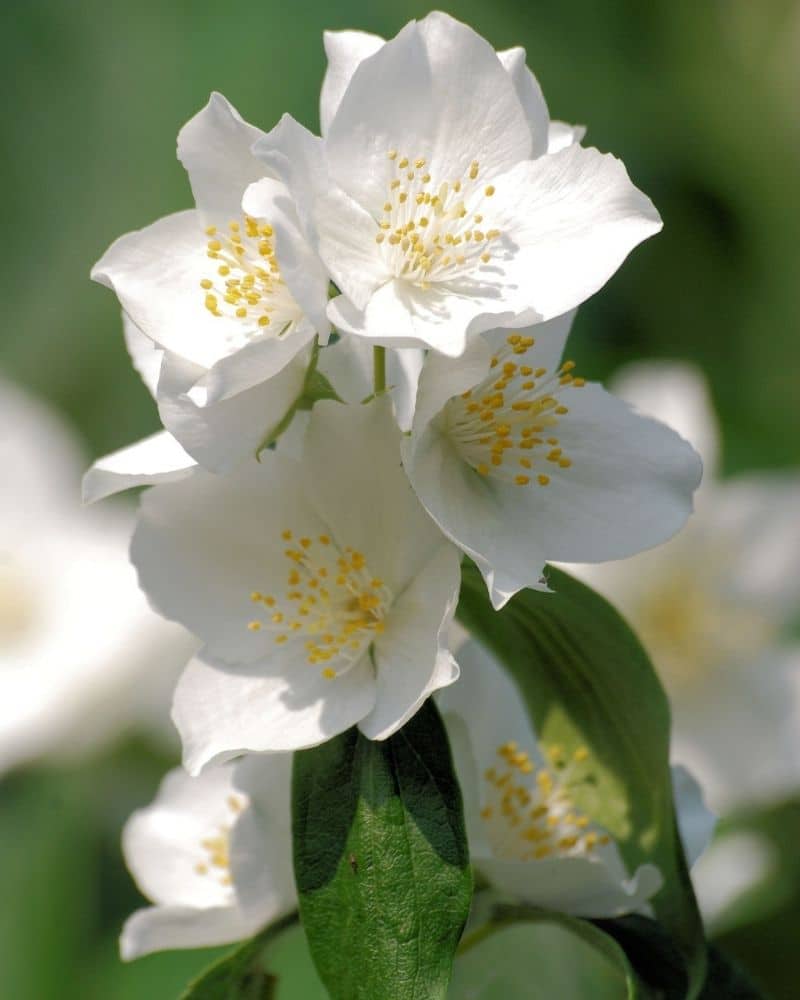The mock orange bush is a fantastic addition to gardens in zones 4 to 7. Although they don’t exactly steal the show for much of the year, they are very showy and fragrant when in flower. Read on to learn more about these popular deciduous shrubs.
What Is A Mock Orange?
The mock orange plant (Philadelphus coronarius) is a beautiful deciduous shrub of the Hydrangaceae family. These plants go by a few different names and are also known as sweet mock orange, golden mock orange, fragrant mock orange, or English dogwood.
Philadelphus coronarius plants are cane-type shrubs that spread by suckering and can reach a height and width of around 12 feet (3.6 m). They have a rounded growth form with graceful arching branches. These plants are native to eastern Europe and western Asia, and they have long been popular garden subjects.
The foliage consists of oppositely arranged simple leaves that may or may not have serrated margins. The leaves measure 2 to 4 inches (5 to 10 cm) long. These trees have light brown bark that often peels off.
Mock Orange Flowers
Mock orange (Philadelphus) flowers are renowned for their fragrant and showy blooms, making them popular additions to gardens. The fragrant flowers, resembling those of citrus plants, feature four white petals and a prominent central cluster of yellow stamens.
The mock orange blossoms are typically borne in clusters, and depending on the variety, they can range in color from white flowers to cream flowers. These blossoms often appear in early spring to early summer, creating a visually appealing display.
Mock oranges are cherished for their ornamental value and the delightful scents that resemble orange blossoms, contributing to a sensory-rich garden experience.

Cultivars And Similar Species
- ‘Aureas’
‘Aureas’ has all the properties of regular Philadelphus, but is a more brightly colored selection that has golden-yellow spring foliage that matures green. This cultivar is especially bold when covered in blossoms.
- ‘Variegatus’
This variegated form provides multi-season interest thanks to its variegated dark green foliage. The leaves of this selection have a thick, cream-white border.
- Virginal mock orange – Philadelphus x virginalis
This popular hybrid Philadelphus grows to about 10 ft (3 m) tall and wide at most and often flowers a little earlier than P. coronarius, from about mid-spring. This is a double or semi-double flowered hybrid that does best in zones 5 to 8.
- Lewis’ mock orange/ Wild mock orange – Philadelphus lewisii
Lewis’s mock orange shrub is a great alternative for American gardeners who prefer to grow native plants. This species grows wild from western Canada, south to California. This is a smaller plant than regular Philadelphus, reaching about 5 to 10 feet tall and wide.
This species grows well in a variety of soils in partial to full sun. Mock orange plants are generally hardy to zone 4, although there is a cultivar known as ‘Blizzard’ that is reliably hardy to zone 3 (1).
- Littleleaf mock orange – Philadelphus microphyllus
The littleleaf mock orange is another native species that grows in the southwestern United States. This small species grows to about 5 feet (1.5 m) tall and wide.
It is less ornamental than regular Philadelphus but is nevertheless suitable for low-maintenance native gardens. These plants are relatively drought-tolerant and do well in zones 5 to 9.
How To Grow Mock Orange
Mock orange shrubs can be grown from seeds planted in the late winter or spring. You will need to cold stratify fresh seeds for 6 to 8 weeks to break their dormancy and stimulate germination.
New plants can also be propagated from softwood or semi-ripe cuttings of about 3 inches (7.5 cm) long. These cuttings root well within 2 months if taken in late spring to mid-summer (2). Using a suitable root hormone powder will improve success and rooting time.
As a plant that spreads by suckering, the easiest way to get new plants is by removing suckers with roots and replanting them.
These plants enjoy loamy soils, so dig in some organic material like compost when planting if you have sandy soil. They are tolerant of a pretty wide range of soil types and pHs, however, and can even be grown in heavier clay soils.
This is not a particularly thirsty shrub once established and will only need watering during dry times unless you live in a hot and dry area. Young plants, however, are more sensitive and should be watered regularly and not allowed to dry out. That being said, these plants do not like ‘wet feet’ so your planting site should drain well. They grow best in full sun to partial shade in USDA hardiness zones 4 to 7.Care and Maintenance
Mock orange bushes are very undemanding, low-maintenance shrubs. These plants do not need frequent pruning and can be neatened up once a year if you like. Since they flower on old wood, pruning in late summer after flowering is recommended (3).
Pinching off long, leggy growth will encourage more lateral branching for a denser shrub. Suckers should also be removed as they emerge if you wish to keep the plant contained. Plants grown in sandy soils will appreciate an annual application of a balanced fertilizer in late winter.
These flowering shrubs are generally pest and disease resistant but can be affected by leafspot, canker, and powdery mildew.
Uses
Horticultural Uses
This is a great shrub for borders and foundations, although it has limited interest outside of the flowering season. It is especially wonderful as an addition to a perfume garden.
Wildlife Uses
Mock orange tree is deer resistant. These plants are frequently enjoyed by butterflies that visit the nectar-rich flowers and birds that eat the seeds.
FAQs
Is mock orange a good cut flower?
Yes, Mock orange (Philadelphus) is indeed a good cut flower. Its fragrant, white blossoms make a lovely addition to floral arrangements.
Which mock orange smells best?
The fragrance of mock orange can vary among different species and cultivars. Many people find that Philadelphus coronarius, commonly known as sweet mock orange, has a particularly pleasant scent.
Where is the best place to plant mock orange?
The best place to plant mock orange is in well-draining soil with access to full sun or partial shade. Mock orange shrubs typically thrive in locations with good air circulation.
Why is my mock orange turning yellow?
Mock orange leaves turning yellow may be due to factors such as nutrient deficiencies, poor soil drainage, or environmental stress. Consider fertilizing with a balanced fertilizer, improving drainage, and ensuring the plant is not experiencing drought stress to address yellowing leaves.
Conclusion
Mock orange shrub is one of those plants that goes about its business quietly for most of the year before reminding you just how wonderful it is when the flowering season comes along. If you enjoy fragrant shrubs that need little maintenance, this is a great plant for your next gardening project.
For more shrubs to grow, go here.
References
Reference List:
- Oregon State University, College Of Agricultural Sciences. Philadelphus Lewisii
https://landscapeplants.oregonstate.edu/plants/philadelphus-lewisii
- Toogood, A. Plant Propagation: The Fully Illustrated Plant-By-Plant Manual Of Practical Techniques.
- Brickel, C. & Joyce, D. Pruning And Training: What, When And How To Prune.
Close
*image by mschuppi/depositphotos







